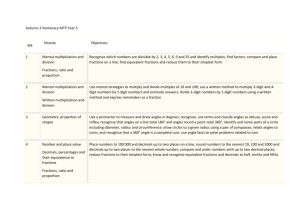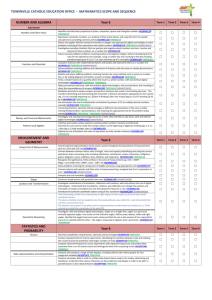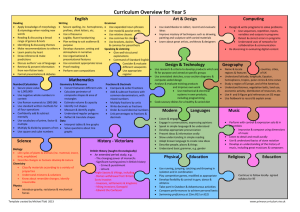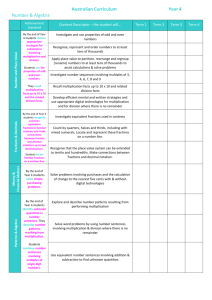PUMA termly content for Y5
advertisement
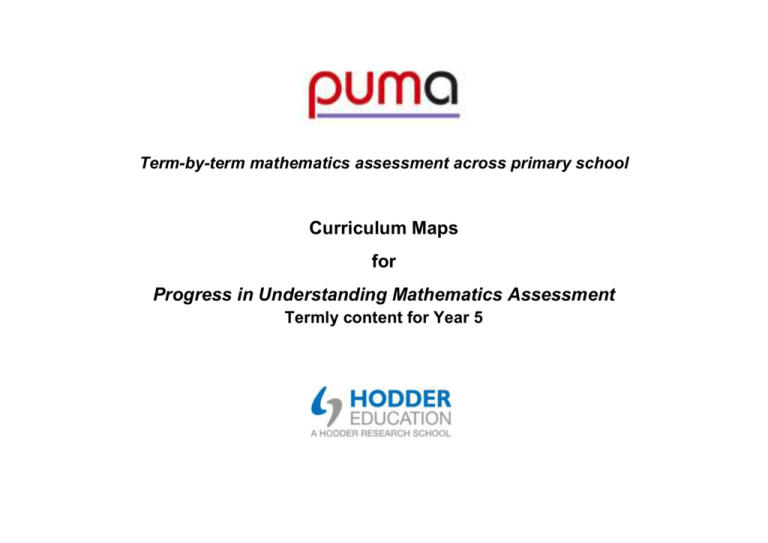
Term-by-term mathematics assessment across primary school Curriculum Maps for Progress in Understanding Mathematics Assessment Termly content for Year 5 The PUMA tests provide thorough coverage of the new National Curriculum Programme of Study for the particular year. These Curriculum Maps take in the new PoS, which describes what should be covered by the end of each year, and suggest how teaching of the material might be allocated to each term. For any test to give reliable results, it needs to be valid – that is, to assess what has been taught – so the Curriculum Maps help to define what PUMA assesses each term. We hope that you will find the Curriculum Maps useful in planning your teaching and for liaison across the school. The PUMA test for each term includes much, but obviously not all, of the curriculum we have described for that term. We anticipate that much of the material is introduced in the Autumn term and reinforced in subsequent terms. Blue highlighting denotes specific material moved down from a higher year. Yellow highlighting denotes content not explicit in the PNS for the year, to help you transfer from your existing lesson planning. Purple text denotes repeated statements. Italics indicate illustrative examples, non-statutory notes and guidance from the new PoS. (NB most of the non-statutory notes and guidance are new, from a higher year, or beyond the PNS.) You will notice a lot of yellow highlighting, to make you aware of even very small changes. It often indicates little more than an expansion and clarification of what you would already be teaching using the PNS. We have also highlighted the same material in all 3 terms, where it is typically taught in the autumn term, but used and reinforced in subsequent terms. Year 5 Autumn Spring Summer NUMBER Number and place value Read, write, order and compare numbers to at least 1 000 000 and determine the value of each digit e.g. order a set of multi-digit numbers from smallest to largest 37 700, 737 570, 737 507, 37 570 Read, write, order and compare numbers to at least 1 000 000 and determine the value of each digit e.g. what is the smallest integer you can make using all of these digits: 8, 1, 0, 5, 6? Count forwards or backwards in steps of powers of 10 from any given number up to 1 000 000 e.g. 197 000, 198 000, 199 000, 200 000, 201 000… Count forwards or backwards in steps of powers of 10 from any given number up to 1 000 000 Interpret negative numbers in context, count forwards and backwards with positive and negative whole numbers through zero e.g. count back in threes: 8, 5, 2, -1, -4, -7… Round any number up to 1 000 000 to the nearest 10, 100, 1000, 10 000 and 100 000 Round any number up to 1 000 000 to the nearest 10, 100 and 1000 e.g. 265 946 to the nearest 1000 (266 000) Solve number problems and practical problems that involve number, place value and rounding e.g. What number is halfway between 560 500 and 560 600? Solve number problems and practical problems that involve number, place value and rounding e.g. What is the largest 4-digit number whose digits sum to 20? (9920). Recognise and describe linear number sequences, including those involving fractions and decimals, and find the term-to-term rule e.g. find the rule and complete the sequence: ___, 16, 8, 4, ___, 1, 0.5, ___ (rule is: halve previous Read, write, order and compare numbers to at least 1 000 000 and determine the value of each digit e.g. What must be added to 37 500 to change it to 67 500? Count forwards or backwards in steps of powers of 10 from any given number up to 1 000 000 Interpret negative numbers in context, count forwards and backwards with positive and negative whole numbers through zero Round any number up to 1 000 000 to the nearest 10, 100, 1000, 10 000 and 100 000 Solve number problems and practical problems that involve number, place value and rounding. e.g. The distance to the bus stop is 1km to the nearest 100m; what is the shortest distance it could be? Recognise and describe linear number sequences, including those involving fractions and decimals, and find the term-to-term rule e.g. find the rule and complete the sequence: ___, 16, 8, 4, ___, 1, 0.5, ___ Read Roman numerals to 1000 number) Addition and subtraction (M) and recognise years written in Roman numerals. e.g. MCMXIV (1914) Add and subtract whole numbers with more than 4 digits, including using formal written methods (columnar addition and subtraction) Add and subtract whole numbers with more than 4 digits, including using formal written methods (columnar addition and subtraction) Add and subtract whole numbers with more than 4 digits, including using formal written methods (columnar addition and subtraction) Add and subtract numbers mentally with increasingly large numbers e.g. 15 400 – 2000 = 13 400 Add and subtract numbers mentally with increasingly large numbers Add and subtract numbers mentally with increasingly large numbers e.g. 12 462 – 2 300 = 10 162 Use rounding to check answers to calculations and determine, in the context of a problem, levels of accuracy Use rounding to check answers to calculations and determine, in the context of a problem, levels of accuracy Solve addition and subtraction multi-step problems in contexts, deciding which operations and methods to use and why e.g. Write a number story for this number sentence: 3709=4562+234-1087 Use rounding to check answers to calculations and determine, in the context of a problem, levels of accuracy Solve addition and subtraction multi-step problems in contexts, deciding which operations and methods to use and why e.g. I have read 124 of the 526 pages of my book; how many more pages must I read to reach the middle? Solve addition and subtraction multi-step problems in contexts, deciding which operations and methods to use and why e.g. I bought some stickers on Monday; on Tuesday I bought 20 more than I bought on Monday; now I have 70; how many stickers did I buy on Monday? Multiplication and division Continue to practise and apply multiplication tables and related division facts, committing them to memory and using them confidently to make larger calculations Continue to practise and apply multiplication tables and related division facts, committing them to memory and using them confidently to make larger calculations Continue to practise and apply multiplication tables and related division facts, committing them to memory and using them confidently to make larger calculations Identify multiples and factors, including finding all factor pairs of a number and common factors of two numbers Identify multiples and factors, including finding all factor pairs of a number and common factors of two numbers Identify multiples and factors, including finding all factor pairs of a number and common factors of two numbers Know and use the vocabulary of prime numbers and composite (non-prime) numbers Know and use the vocabulary of prime numbers and composite (non-prime) numbers Establish whether a number up to 100 is prime and recall prime numbers up to 19 Establish whether a number up to 100 is prime and recall prime numbers up to 19 Solve problems involving multiplication and division where larger numbers are used by decomposing them into their factors e.g. 828÷36 = (828÷4)÷9 = 207÷9 = 23 Multiply numbers up to 4 digits by a one- or two-digit number using a formal written method, including long multiplication for two-digit numbers Know and use the vocabulary of prime numbers, prime factors and composite (non-prime) numbers e.g. prime factors of 60=2×2×3×5 Multiply and divide numbers mentally drawing upon known facts e.g. 630÷9 Establish whether a number up to 100 is prime and recall prime numbers up to 19 Multiply numbers up to 4 digits by a one- or two-digit number using a formal written method, including long multiplication for two-digit numbers Multiply and divide numbers mentally drawing upon known facts e.g. 840÷12 Multiply numbers up to 4 digits by a one- or two-digit number using a formal written method, including long multiplication for two-digit numbers Multiply and divide numbers mentally drawing upon known facts e.g. 60×9 Multiply and divide whole numbers and those involving decimals by 10, 100 and 1000 e.g. 456÷100=4.56 Multiply and divide whole numbers and those involving decimals by 10, 100 and 1000 Divide numbers up to 4 digits by a one-digit number using the formal written method of short division and interpret remainders Solve problems involving addition, subtraction, multiplication and division and a combination of these, including understanding the meaning of the equals sign e.g. 40×8=500 - appropriately for the context e.g. 98 ÷ 4 = 24 r 2 = 24½ = 24.5 ≈ 25. Recognise and use square numbers and cube numbers, and the notation for squared (2) and cubed (3) Solve problems involving addition, subtraction, multiplication and division and a combination of these, including understanding the meaning of the equals sign e.g. There are 6 shelves of books; 3 shelves hold 35 books each, one shelf holds 45 books and the top two shelves have the same number of books on each; there are 200 books altogether; how many books are on the very top shelf? Multiply and divide whole numbers and those involving decimals by 10, 100 and 1000 Divide numbers up to 4 digits by a one-digit number using the formal written method of short division and interpret remainders appropriately for the context Recognise and use square numbers and cube numbers, and the notation for squared (2) and cubed (3) Solve problems involving addition, subtraction, multiplication and division and a combination of these, including understanding the meaning of the equals sign Solve problems involving multiplication and division, including scaling by simple fractions and problems involving simple rates.eg a toymaker can make 8 toys in 2 hours; how many toys can he make in 5 hours? Fractions (including decimals and percentages) Know that percentages, decimals and fractions are different ways of expressing proportions Know that percentages, decimals and fractions are different ways of expressing proportions Know that percentages, decimals and fractions are different ways of expressing proportions Count forwards and backwards in fractions and decimals bridging zero Count forwards and backwards in fractions and decimals bridging zero Count forwards and backwards in fractions and decimals bridging zero Compare and order fractions whose denominators are all multiples of the same number e.g. put these fractions in order from the smallest: 5/12, 5/6, 11/12, 2/3 Compare and order fractions whose denominators are all multiples of the same number Compare and order fractions whose denominators are all multiples of the same number Identify, name and write equivalent fractions of a given fraction, represented visually, including tenths and hundredths making links to decimals and measures Connect fractions >1 to division with remainders e.g. 5/4 = 5÷4=11/4 Identify, name and write equivalent fractions of a given fraction, represented visually, including tenths and hundredths and extending to thousandths, making links to decimals and measures e.g. 755/1000 kg = 0.755kg Recognise mixed numbers and improper fractions and convert from one form to the other e.g. 5 2 /3 = 17/3 and write mathematical statements >1 as a mixed number e.g. 2/5 + 4/5 = 6/5 = 11/5 Connect fractions >1 to division with remainders e.g. 37/5 = 37÷5=72/5 Recognise mixed numbers and improper fractions and convert from one form to the other e.g. 5 2 /3 = 17/3 and write mathematical statements >1 as a mixed number Add and subtract fractions with the same denominator and multiples of the same number e.g. 2/5 + 7/10 = 11 /10 = 11/10 Find fractions of numbers and quantities e.g. 7/8 of 240ml Identify, name and write equivalent fractions of a given fraction, represented visually, including tenths and hundredths making links to decimals and measures e.g. 37/100 metre = 0.37m Read and write decimal numbers as fractions e.g. 0.71 = 71/100 Mentally add and subtract: o tenths e.g. 0.8 - 0.3 o one-digit whole numbers and tenths e.g. 3.4 + 2.6 o complements of 1 e.g. 0.85 + 0.15 = 1 Recognise the per cent symbol (%) and understand that per cent relates to “number of parts per hundred”, and write percentages as a fraction with denominator hundred, and as a decimal fraction e.g. 43% = 43/100 = 0.43 Add and subtract fractions with the same denominator and multiples of the same number e.g. 2/3 + 1/6 = 5/6 Find fractions of numbers and quantities e.g. 3/4 of £14 Connect multiplication by a fraction to using fractions as operators e.g. 2 /3 of 12 = 12 × 2/3 Recognise that percentages are proportions of quantities e.g. 40% of the class are boys; what percentage are girls? as well as operators on quantities e.g. find 40% of 30 children. Connect multiplication by a fraction to using fractions as operators e.g. 8 /5 of 40 = 40 × 8/5 Mentally add and subtract: o tenths e.g. 0.8 + 0.9 o one-digit whole numbers and tenths e.g. 3.1 – 2.9 o complements of 1 e.g. 0.83 + 0.17 = 1 Multiply proper fractions and mixed numbers by whole numbers, supported by materials and diagrams. e.g. use egg boxes to represent 25/6 × 3 = 615/6= 83/6= 81/2 Add and subtract decimals with a different number of decimal places e.g. 102.3 + 97.82 Read and write decimal numbers as fractions e.g. 0.8=4/5 Mentally add and subtract: o tenths e.g. 0.8 + 0.9 – 0.2 o one-digit whole numbers and tenths e.g. 7.4 – 6.6 o complements of 1 e.g. 0.83 + 0.17 = 1 Add and subtract decimals with a different number of decimal places e.g. 98.4 – 9.7 Round decimals with two decimal places to the nearest whole number and to one decimal place Recognise and use thousandths and relate them to tenths, hundredths and decimal equivalents e.g. 782/1000 = 7/10 + 8/100 + 2/1000 Read, write, order and compare numbers with up to three decimal places e.g. put these decimals in Read and write decimal numbers as fractions Round decimals with two decimal places to the nearest whole number and to one decimal place e.g. 27.59=27.6 (1d.p.) Recognise and use thousandths and relate them to tenths, hundredths and decimal equivalents e.g. 650/1000 = 65/100 = 0.65; Read, write, order and compare numbers with up to three decimal places e.g. put these decimals in order starting from the smallest: 0.457, 0.42, 0.46, 0.426 Solve problems and puzzles involving number up to three decimal places, checking the reasonableness of answers Recognise the per cent symbol (%) and understand that per cent relates to “number of parts per hundred”, and write percentages as a fraction with denominator hundred, and as a decimal fraction order starting from the smallest: 0.471, 0.46, 0.4, 0.465, 0.5 Recognise that percentages are proportions of quantities as well as operators on quantities Solve problems and puzzles involving number up to three decimal places, checking the reasonableness of answers Solve problems which require knowing percentage and decimal equivalents of 1/2, 1/4, 1/5, 2/5, 4/5 and those with a denominator of a multiple of 10 or 25.e.g. 12/20 = 60 /100 = 0.6 = 60% Recognise the per cent symbol (%) and understand that per cent relates to “number of parts per hundred”, and write percentages as a fraction with denominator hundred, and as a decimal fraction Recognise that percentages are proportions of quantities e.g. 30% voted ‘yes’, 45% voted ‘no’ and the rest did not vote; what percentage did not vote? as well as operators on quantities e.g. find 45% of 160 MEASUREMENT Convert between different units of measure (e.g. kilometre and metre; centimetre and metre; centimetre and millimetre; gram and kilogram; litre and millilitre) e.g. 15.7cm = 157mm Convert between different units of measure (e.g. kilometre and metre; centimetre and metre; centimetre and millimetre; gram and kilogram; litre and millilitre) e.g. 3.7 litres = 3700ml Solve problems which require knowing percentage and decimal equivalents of 1/2, 1/4, 1/5, 2/5, 4/5 and those with a denominator of a multiple of 10 or 25. e.g. John ate 4/5 of a 20cm jelly snake; Jane ate 0.7 of her 20cm jelly snake; how much more has John eaten? Convert between different units of measure (e.g. kilometre and metre; centimetre and metre; centimetre and millimetre; gram and kilogram; litre and millilitre) e.g. 2.2m = 2200mm Measure and calculate the Measure and calculate the Measure and calculate the perimeter of composite rectilinear shapes in centimetres and metres e.g. find the perimeter of an L shape where one or two side lengths are not given Calculate and compare the area of squares and rectangles including using standard units, square centimetres (cm2) and square metres (m2) and estimate the area of irregular shapes Use all four operations to solve problems involving measure (e.g. length, mass, volume, money) using decimal notation including scaling perimeter of composite rectilinear shapes in centimetres and metres e.g. given the perimeter and length of a rectangle, calculate its width,w, expressing it algebraically e.g. 20 = (2×7) + 2w perimeter of composite rectilinear shapes in centimetres and metres Calculate and compare the area of squares and rectangles including using standard units, square centimetres (cm2) and square metres (m2) and estimate the area of irregular shapes Calculate and compare the area of squares and rectangles including using standard units, square centimetres (cm2) and square metres (m2) and estimate the area of irregular shapes e.g. investigate possible rectangles with the same area as a particular square Estimate volume e.g. using 1cm3 blocks to build cubes and cuboids and capacity e.g. using water Estimate volume e.g. using 1cm3 blocks to build cubes and cuboids and capacity e.g. using water Solve problems involving converting between units of time e.g. three children share a trophy for 8 weeks and 4 days; they each have it for the same length of time; how long does each child keep the trophy? Use all four operations to solve problems involving measure (e.g. length, mass, volume, money) using decimal notation including scaling Calculate the area of scale drawings using given measurements. e.g. calculate the area of a 5cm × 3cm garden on a scale drawing with a scale 1cm:2m (60m2) Understand and use equivalences Solve problems involving converting between units of time e.g. write these lengths of time in order, starting with the smallest: 250sec, 90min, ½ hour, 4min Use all four operations to solve problems involving measure (e.g. length, mass, volume, money) using decimal notation including scaling between metric and common imperial units such as inches, pounds and pints e.g. Given that an inch is approximately 2.5cm, calculate the metric equivalent of a foot (12 inches) GEOMETRY Properties of shapes Identify 3-D shapes, including cubes and other cuboids, from 2-D representations e.g. using isometric paper Draw lines accurately to the nearest millimetre and use conventional markings for parallel lines and right angles. Know angles are measured in degrees: estimate and compare acute, obtuse and reflex angles Use the properties of rectangles to deduce related facts and find missing lengths and angles e.g. all angles are right angles, diagonals are congruent (same length) and bisect each other (divide into two equal parts), one diagonal separates the rectangle into two congruent triangles… Identify 3-D shapes, including cubes and other cuboids, from 2-D representations Identify 3-D shapes, including cubes and other cuboids, from 2-D representations Draw lines accurately to the nearest millimetre and use conventional markings for parallel lines and right angles. Draw lines accurately to the nearest millimetre and use conventional markings for parallel lines and right angles. Know angles are measured in degrees: estimate and compare acute, obtuse and reflex angles Know angles are measured in degrees: estimate and compare acute, obtuse and reflex angles Draw given angles, and measure them in degrees (°) Draw given angles, and measure them in degrees (°) Identify: o angles at a point and one whole turn (total 360°) o angles at a point on a straight line and ½ a turn (total 180°) o other multiples of 90° Identify: o angles at a point and one whole turn (total 360°) o angles at a point on a straight line and ½ a turn (total 180°) o other multiples of 90° Use angle sum facts and other properties to make deductions about missing angles Use angle sum facts and other properties to make deductions about missing angles Use the properties of rectangles to deduce related facts and find missing lengths and angles e.g. all Use the properties of rectangles to deduce related facts and find missing lengths and angles e.g. all angles are right angles, diagonals are congruent (same length) and bisect each other (divide into two equal parts), one diagonal separates the rectangle into two congruent triangles… Position and direction Use the term diagonal and make conjectures about the angles formed by diagonals and sides, and other properties of quadrilaterals, e.g. using dynamic geometry ICT tools. angles are right angles, diagonals are congruent (same length) and bisect each other (divide into two equal parts), one diagonal separates the rectangle into two congruent triangles… Use the term diagonal and make conjectures about the angles formed by diagonals and sides, and other properties of quadrilaterals, e.g. using dynamic geometry ICT tools. Distinguish between regular and irregular polygons based on reasoning about equal sides and angles e.g. sort triangles and quadrilaterals into regular and irregular sets, realising that only the equilateral triangles and the squares are regular Identify, describe and represent the position of a shape following a reflection or translation, using the appropriate language, and know that the shape has not changed. Identify, describe and represent the position of a shape following a reflection or translation, using the appropriate language, and know that the shape has not changed. Identify, describe and represent the position of a shape following a reflection or translation, using the appropriate language, and know that the shape has not changed. Complete, read and interpret information in tables, including timetables. Complete, read and interpret information in tables, including timetables. Complete, read and interpret information in tables, including timetables. Solve comparison, sum and difference problems using information presented in a line graph e.g. on a distance-time graph, how long did it take to Solve comparison, sum and difference problems using information presented in line graphs STATISTICS Use and interpret data travel a particular distance? Connect work on coordinates and scales to their interpretation of time graphs Connect work on coordinates and scales to their interpretation of time graphs Begin to decide which representations of data are most appropriate and why


